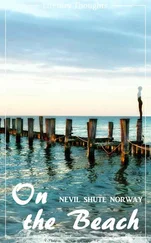In steamships to the Kolyma everything was the same as on the barges except that everything was on a larger scale. Strange as it seems, some of the prisoners sent to the Kolyma in several overage old tubs on the famous expedition led by the ice-breaker Krasin in the spring of 1938 are still alive today. On the steamers Dzhurma, Kulu, Nevostroi, Dneprostroi, for which the Krasin was breaking the way through the spring ice, there were also three decks in the cold, dirty holds, and on these decks, in addition, there were two-story bunks made out of poles. It was not completely dark: there were some kerosene lanterns and lamps. The prisoners were allowed up on deck in batches for fresh air and walks. Three to four thousand prisoners were in each steamer. The voyage took more than a week, and before it was over all the bread brought aboard in Vladivostok got moldy and the ration was reduced from twenty-one to fourteen ounces a day. They also gave out fish, and as for drinking water… Well, there’s no reason to gloat here, because there were temporary difficulties with the water. Here, in contrast to the river transports, there were heavy seas, storms, seasickness. The exhausted, enfeebled people vomited, and didn’t have the strength to get up out of their vomit, and all the floors were covered with the nauseating mess.
There was one political incident on the voyage. The steamers had to pass through La Perouse Strait, very close to the Japanese islands. And at that point the machine guns disappeared from the watchtowers and the convoy guards changed to civilian clothes, the hatches were battened down, and access to the decks was forbidden. According to the ships’ papers, foresightedly prepared back in Vladivostok, they were transporting, God save us, not prisoners but volunteers for work in the Kolyma. A multitude of Japanese small craft and boats hovered about the ships without suspecting. (And on another occasion, in 1938, there was an incident involving the Dzhurma: The thieves aboard got out of the hold and into the storage room, plundered it, and set it afire. The ship was very close to Japan when this occurred. Smoke was pouring from it, and the Japanese offered help, but the captain refused to accept it and even refused to open the hatches. When Japan had been left behind, the corpses of those suffocated by smoke were thrown overboard, and the half-burned, half-spoiled food aboard was sent on to camp as rations for the prisoners.) [308]
Short of Magadan the ship caravan got caught in the ice and not even the Krasin could help (it was too early for navigation, but they had been in a hurry to deliver laborers). On May 2 they disembarked the prisoners on the ice, some distance from the shore. The newly arrived prisoners got a look at the cheerless panorama of the Magadan of that time: dead hillocks, neither trees, nor bushes, nor birds, just a few wooden houses and the two-story building of “Dalstroi.” Nonetheless, continuing to play out the farce of correction, in other words, pretending they had brought not simply bones with which to pave the gold-bearing Kolyma but temporarily isolated Soviet citizens who would yet return to creative life, they were greeted by the Dalstroi orchestra. The orchestra played marches and waltzes, and the tormented, half-dead people strung along the ice in a gray line, dragging their Moscow belongings with them (and this enormous prisoner transport consisted almost entirely of politicals who had hardly encountered a single thief yet) and carrying on their shoulders other half-dead people—arthritis sufferers or prisoners without legs. (And the legless, too, got prison terms.)
But here I note that I am again beginning to repeat myself. And this will be boring to write, and boring to read, because the reader already knows everything that is going to happen ahead of time: The prisoners would be trucked hundreds of miles, and driven dozens of miles more on foot. And on arriving they would occupy new camp sites and immediately be sent out to work. And they would eat fish and flour, chased down with snow. And sleep in tents.
Yes, it was like that. But first the authorities would put them up in Magadan, also in Arctic tents, and would commission them there too—in other words, examine them naked to determine their fitness for labor from the condition of their buttocks (and all of them would turn out to be fit). In addition, of course, they would be taken to a bath and in the bath vestibule they would be ordered to leave their leather coats, their Romanov sheepskin coats, their woolen sweaters, their suits of fine wool, their felt cloaks, their leather boots, their felt boots (for, after all, these were no illiterate peasants this time, but the Party elite—editors of newspapers, directors of trusts and factories, responsible officials in the provincial Party committees, professors of political economy, and, by the beginning of the thirties, all of them understood what good merchandise was). “And who is going to guard them?” the newcomers asked skeptically. “Oh, come on now, who needs your things?” The bath personnel acted offended. “Go on in and don’t worry.” And they did go in. And the exit was through a different door, and after passing through it, they received black cotton breeches, field shirts, camp quilted jackets without pockets, and pigskin shoes. (Oh, this was no small thing! This was farewell to your former life—to your titles, your positions, and your arrogance!) “Where are our things?” they cried. “Your things you left at home!” some chief or other bellowed at them. “In camp nothing belongs to you. Here in camp we have communism! Forward march, leader!”
And if it was “communism,” then what was there for them to object to? That is what they had dedicated their lives to.
And there are also prisoner transports in carts and simply on foot. Do you remember in Tolstoi’s Resurrection how on a sunny day they drove them on foot from the prison to the railroad station? Well, in Minusinsk in 194-, after the prisoners hadn’t been taken into the fresh air for a whole year, they had forgotten how to walk, to breathe, to look at the light. And then they took them out, put them in formation, and drove them the fifteen miles to Abakan on foot. About a dozen of them died along the way. And no one is ever going to write a great novel about it, not even one chapter: if you live in a graveyard, you can’t weep for everyone.
A prisoner transport on foot—that was the grandfather of prisoner transport by rail, of the Stolypin car, and of the red cattle cars too. In our time it is used less and less, and only where mechanical transportation is still impossible. Thus in one sector of Lake Ladoga, the prisoners were sent on foot from besieged Leningrad to the red cars, nicknamed “red cows” They led the women together with the German POW’s, and used bayonets to keep our men away from them so they couldn’t take their bread. Those who fell by the wayside were immediately tossed up into a truck alive or dead, after their shoes were removed. And in the thirties, each day they sent off on foot from the Kotlas Transit Prison to Ust-Vym (about 185 miles) and sometimes to Chibyu (more than 300 miles) a transport of a hundred prisoners. Once in 1938 they sent off a women’s prisoner transport the same way. These transports covered 15 miles a day. The convoy marched along with one or two dogs, and those who fell behind were urged on with gunstocks. True, the prisoners’ possessions as well as the cooking pot and the food brought up the rear in carts, and this transport thus recalled the classic prisoner transports of the past century. There were also prisoner-transport huts—the ruined houses of liquidated kulaks, with windows broken and doors ripped off. The accounting office of the Kotlas Transit Prison had issued provisions to the transport based on a theoretical estimate of the time the journey would take, provided nothing went wrong on the way, without allowing for even one extra day. (The basic principle of all our accounting.) Whenever delays occurred en route, they had to stretch out the provisions, and fed the prisoners a mash of rye flour without salt and sometimes nothing at all. In this respect they departed from the classic model.
Читать дальше












